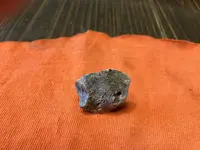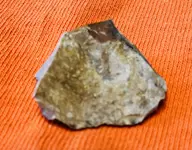The edge exhibits some conchoidal fractures, but it is natural most likely. It is hard for people to conceptualize just how old most rocks are, and the natural processes they have been subjected to during hundreds of millions to billions of years. The magnitude of the time span is incredible. Some rocks are parts of long gone mountain ranges. Rivers and entire oceans have come and gone. Glaciers have formed and melted completely.
My point here is that any stone capable of exhibiting conchoidal fracture very likely will. It is a simple rule, but is broadly applicable to any rock. At some point the stone will have been subjected to natural forces like pressure and crushing from being buried, tumbling in a river or as part of sheet wash on a mountainside, or field plowing damage. Heck, a dinosaur or extinct bison species could have stepped on it. Most stones showing conchoidal fracture are 'just a rock' as they say. A relatively small percentage will be culturally modified. Sometimes there is a stone which is impossible to place into either category, in which case I would err on the side of caution and consider natural in origin. Mankind has known about working stone for millions of years, and even Acheulean hand axes exhibit very intentional and systematic modification.
Don't feel bad about not knowing for sure. I once saw an entire archaeological field crew of about 15 people with post graduate degrees get completely fooled by a piece of obsidian which has been scraped along one edge by a road grader. The thing was flaked uniformly along one side of one entire edge. It was flaked, but it was not culturally modified.








